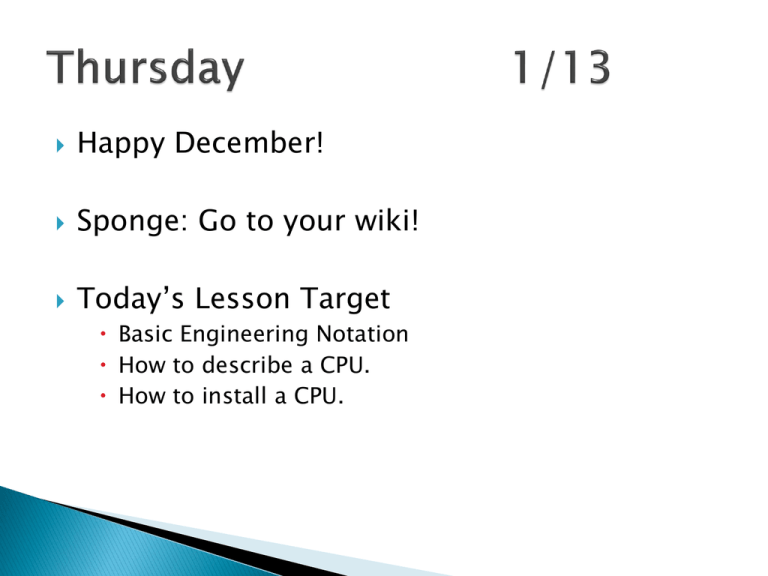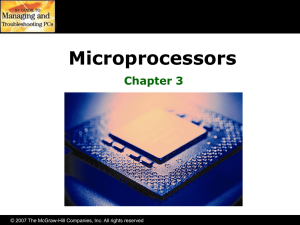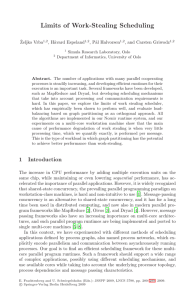Thursday 12/1
advertisement

Happy December! Sponge: Go to your wiki! Today’s Lesson Target Basic Engineering Notation How to describe a CPU. How to install a CPU. Kilo (K) 210 1,024 (about 1,000) Kilobyte (KB) Mega (M) 220 1,048,576 (about one million) Megabyte (MB) Giga (G) 230 1,073,741,824 (about one billion) Gigabyte (GB) Tera (T) 240 1,099,511,627,776 (about one trillion) Terabyte (TB) A single 0 or 1 is a bit (b) One byte (B) is 8 bits There are four main things to describe and compare CPUs: ◦ Make Intel and AMD ◦ Model Core i7, Core i5, Pentium 4, Xeon, Athlon ◦ Speed Measured in MHz or GHz such as 266 MHz or 3.2 GHz ◦ How it’s mounted Slotted or socketed Most desktop processors are socketed Staggered Pin Grid Array (SPGA) ◦ Pins are staggered and more closely packed to keep the overall size of the package small • Single Edge Contact Cartridge (SECC) – Take up less space and enable better cooling of the CPU. Obsolete – Celeron, Pentium II, Pentium III, Athlon CPU makers have added a large number of improvements over the years ◦ Faster processor speeds ◦ Larger memory banks Intel introduced the Pentium CPU in the early 1990s ◦ ◦ ◦ ◦ ◦ 32-bit registers Speeds up to 300 MHz Ability to run multiple programs at once Access super-fast cache RAM Processes two or more lines of code at the same time Multiprocessing is running two programs at the same time Pentium processors have a 32-wire address bus that can address up to 232 or about four gigabytes of memory ◦ Actually CPUs do not run two programs at once. They simply switch back-and-forth between them so that it looks like they are doing two things at once. Cost ◦ Chances are you’ll need to replace the motherboard as well as the CPU – is it worth it? Cooling ◦ Faster CPUs will probably need better cooling Performance ◦ Faster CPUs may not be the best answer to speeding up your PC Many times what you really need is more RAM Consult your motherboard manual ◦ You need a CPU that will fit in the socket you have on your motherboard Buying a CPU ◦ Most stores will not accept returns ◦ Retail-boxed CPUs are genuine and come with a fan ◦ There are a lot of illegal CPUs on the market Don’t touch the pins Match the notch and dot printed on the corners of the CPU…it must line up ◦ Incorrectly installing your CPU may destroy the CPU and/or motherboard! Install a fan on top of the CPU after the CPU has been inserted into the socket ◦ Use a heat sink compound Modern CPUs need to be kept cool ◦ OEM fans are included in retail-boxed CPUs ◦ Liquid cooling works by running a liquid (usually water) through a metal block that sits on top of your CPU to absorb heat Overclocking is running a CPU at a speed higher than rated ◦ Voids the warranty ◦ Black market exists







